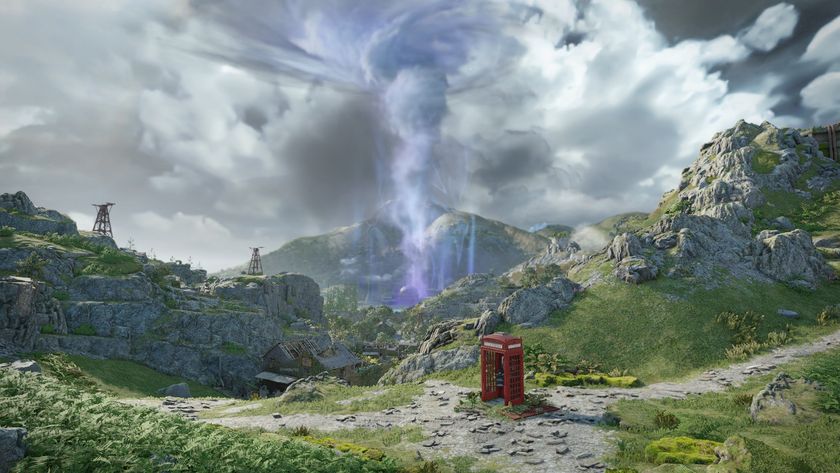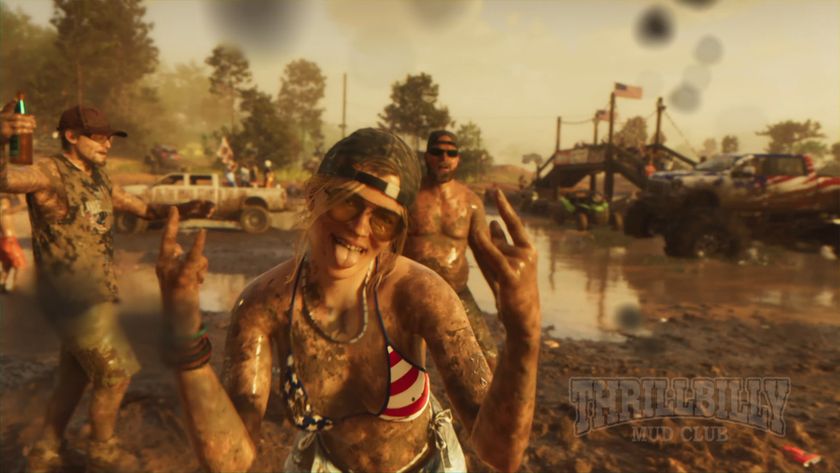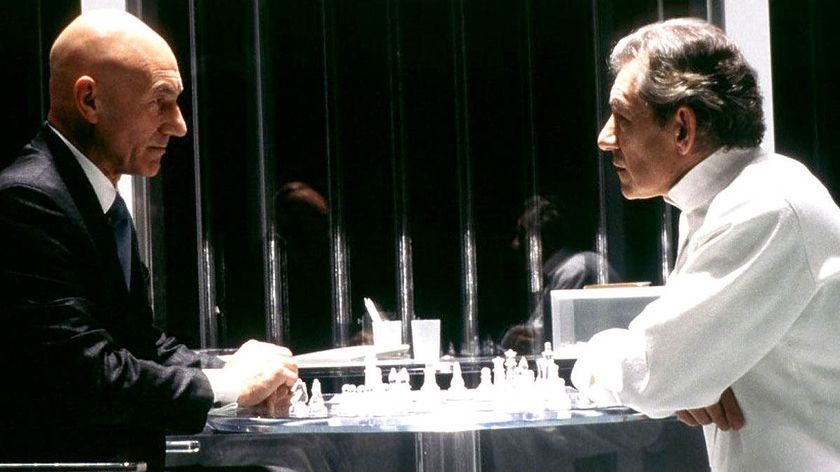The developers behind iconic Star Wars games talk Legends, the Force, and exploring a vast universe
Retro Gamer chats with Star Wars Legends video game developers
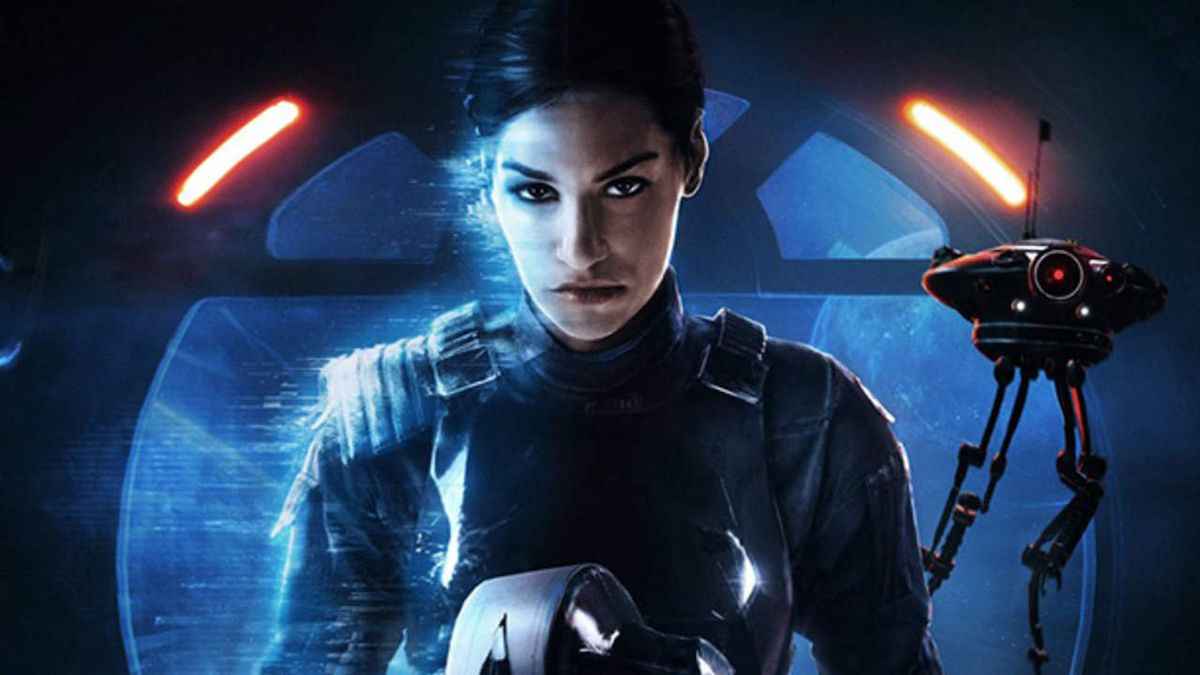
When George Lucas first sat down to pen a story about a hopeful farm boy with dreams of space travel, odds are he didn't foresee how popular further adventures set in that galaxy far, far away would become. Forget spawning eight direct sequels and a handful of spin-offs, Star Wars also went on to be explored in realms outside of the standard movie format – including comics, books and countless video game tie-ins that made immersing yourself into this world of Wookiees and space wizards easier than ever.
Then suddenly, on April 25, 2014, the new Disney overlords saw fit to de-canonise almost four decades' worth of Expanded Universe stories. Those tales of bravery, triumph, and tyranny still exist, sure, yet now they're referred to as 'Legends' that sit firmly out of the main Star Wars timeline. Disney has since decided to cherry-pick certain concepts from this period, when the EU was the only source of new material for Star Wars fans, and integrate them into its own plans. Thank the Force, too, because while some may consider the period between each trilogy's release – when Star Wars movies were absent – inconsequential to the Skywalker saga, for a whole generation of fans names like Rianna Saren, Bastila Shan, and Kyle Katarn carry a lot of credence.
Heroes such as these demonstrated that Star Wars could be so much more than simply Luke Skywalker, Han Solo, and Leia Organa. A feat not possible were it not for the talented developers that were tasked with respecting Lucasfilm's established canon while finding room to innovate and introduce their own.
The Force according to Kyle
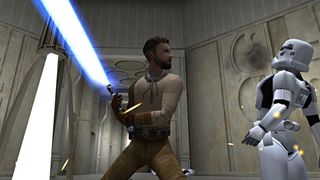
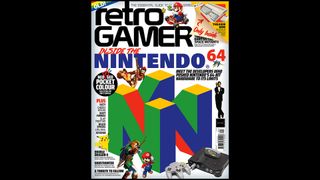
For more in-depth features exploring classic games and consoles delivered right to your door or device, subscribe to Retro Gamer today in print or digital.
"A reluctant hero fighting against a new threat." That's how Raven Software's Christopher Foster describes Kyle Katarn, arguably one of the most famous protagonists in all of Star Wars video games. First introduced in Dark Forces (1995), through him players finally got to experience events only hinted at in the original trilogy. The game's opening mission, for example, depicts his attempt to steal the Death Star plans (yes, those ones). Turns out it involved blasting away endless legions of stormtroopers held up in an Empire base situated on the planet Danuta.
Admittedly, this opening mission served more as a prelude for events to come, but still, it highlighted LucasArts' willingness to fill out this rich sci-fi universe in video game form. Katarn himself was so popular, in fact, that his imperial-turned-rebel-mercenary journey became the nexus point in a series of Star Wars games that would sit under the Jedi Knight banner. Because while Dark Forces solely let players view the action from behind the sights of a blaster, all three sequels gradually expanded on this core combat.
By the time Raven Software took over development duties from LucasArts for Star Wars Jedi Knight 2: Jedi Outcast (2002), learning how to properly wield a lightsaber became equally as important as traditional first-person gunplay. This all happened at an exciting time for Star Wars, when the prequel trilogy was confirmed by Lucas as a sure thing. As such, LucasArts needed a team that had hunger, drive and, most importantly, could do justice continuing Katarn's story in the period set after Return Of The Jedi. Having proved its ability with games like Heretic II and Elite Force, Chris Foster and his superfan colleagues at Raven Software jumped at the opportunity to create a follow-up that was exciting and engaging. One of the primary methods they went about doing this was by iterating on the lightsaber combat that was introduced in Dark Forces 2.
Our team wanted the lightsaber combat to not just be a guy waving a stick around that one-shotted enemies.
Chris Foster, former LucasArts designer
"Our team wanted the lightsaber combat to not just be a guy waving a stick around that one-shotted enemies," Foster reveals. "Previous games had shown us that it could almost be a living extension of the player – we wanted it to be the ultimate combination of a weapon and an extension of the player's will." Raven underwent rigorous prototyping to ensure it wouldn't feel clunky. "We tested out the first stormtrooper AI, using buttons, puzzles, Force powers and of course, the lightsaber. [We] tweaked timing, animations, reactions, damage and the blaster parrying mechanics until they felt the way we needed them to be." For as improved lightsaber wielding in Jedi Outcast now was, it also wasn't lost on Raven just how important the legendary weapon should be handled story-wise. Much like how Obi-Wan gifting Luke his father's lightsaber represents a turning point in his story, Kyle Katarn needed a similar moment – especially since the sequel picks up after he's cut himself off from the Force completely.
Sign up to the 12DOVE Newsletter
Weekly digests, tales from the communities you love, and more
Fortunately, it arrives early on at the Valley Of The Jedi, after Katarn allegedly loses his friend and close ally Jan Ors at the hands of a Dark Jedi. "When you picked up that lightsaber after having used guns for the start of the game, we wanted you to know you had arrived," Foster concludes. "Having that thing in your hand was your destiny and it was a part of you."
KOTOR
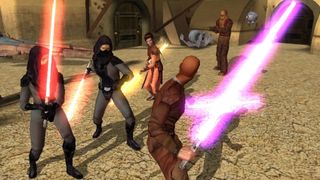
Knights Of The Old Republic (2003) is yet another Star Wars game that treats this important Jedi rite of passage with the significance and excitement it deserves. As a full-blown RPG rather than an action game, such moments are generally given more time to breathe. Taking place approximately 4,000 years prior to the birth of Luke Skywalker, this was just one of many freedoms BioWare had given itself when choosing to set a game so far before anything else Star Wars.
Whereas Raven and other developers making tie-in games between the prequel era and Disney acquisition were often forced to work around canonical gaps situated between episodes, here there was no such problem. It was an easy decision, as BioWare cofounder and executive producer on KOTOR Greg Zeschuck remembers. "We had a choice of current or prior, and we didn't really want prior at all because we knew the Star Wars Galaxies guys quite well and they had a tough time with scrutiny. [Theirs] was somewhere in the phase where there can't be lots of Jedi, so no players can be Jedi. We always said that's the dumbest thing on the face of the Earth."
Greg and his team understood that engaging players using a proper hero's journey arc meant making them a Jedi, and did this by letting them create their own character – a hallmark of the RPG genre BioWare specialised in. KOTOR's ultimate goal was to reflect everything through the player. An ethos that went so far as to inform how its story and dialogue was structured. You'd be able to make decisions that leant either on the Light or Dark Side of the Force, having companion characters and the world at large react to them. The beginnings of such ideas are seen in other BioWare role-playing games such as Baldur's Gate II and Neverwinter Nights, but the studio wanted to push the visual representation of these role-playing elements further than before.
"It was actually after a few months when we realised that we should change the character's appearance depending on which side of the Force they fall on," Zeschuck reveals. "It really had to be all about the character. That was the big revelation for us. The idea that you could reflect in your on-screen character with subtle changes. I was the one who proposed the bags under the eyes if they turn evil and they start looking haggard. Everyone laughed, 'That's ridiculous.' Well, two weeks later they were like, 'Yeah, that's what we're doing.'"
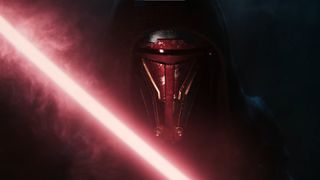
Visual changes made for a rather unique depiction of the Force, yet little did BioWare know that it was also laying the groundwork for its own sci-fi RPG universe in Mass Effect a few years later. Part of what makes KOTOR so memorable in many players' minds is its grand scope. Whereas most other Star Wars games released up until this point focussed on linear campaigns that spanned various genres, here was a take on Lucasfilm's IP that could be approached in multiple different ways. Not only in terms of the alignment system which saw you err on the side of Jedi or Sith, but also in the cinematic, round-based battles. This introduced an element of chance to combat and forced you to think more strategically.
As a holdover from BioWare's fondness of tabletop RPGs and work on previous games, the studio experimented with real-time action before settling on something more filmic. "Up to that point all Star Wars games had been action games, there'd been no strategy or turn-based," says Zeschuck. "We really felt that the game would be better with a party, and those things are in direct conflict. That's why we created something that was halfway between... where you could play it as an action game if you wanted but for the really difficult battles you pause it, set up some moves, let it run a bit and then pause again. "If you went solo, that'd be different right? If it was just you running around it'd feel empty from a story perspective. You wouldn't have all these characters reflecting the world back at you, so from our perspective it was important to find a solution. We also didn't want to lose the cinematic flair of Star Wars. You know it's actually quite fantastic to watch, with all the lightsabers flying and all the clashing. We still wanted that, too, so that's how we landed on the 'pause and play' approach."
For a single-player experience as it is, you never feel alone in Knights Of The Old Republic thanks to the eclectic range of AI-controlled party members crafted by BioWare's writing team. From roguish war hero Carth Onsai and honourable Jedi Bastila Shan, to the Star Wars saga's first openly gay character in Juhani, these characters' different personalities added to the game's sense of grandeur and sophistication. Your ultimate mission might be to track down and defeat Darth Malak's evil threat, but it wouldn't be as memorable without friends by your side.
The success of KOTOR inevitably led to a sequel, although it was Obsidian Entertainment and not BioWare that handled development. Set five years after the events of the first game, KOTOR 2: The Sith Lords focused on 'The Exile', who had served under Darth Revan and committed such heinous crimes that they severed their ties to the Force in order to survive. While it lacks the polish of its predecessor, it was praised on release for its complex story and rich characters which expanded the arcs of existing KOTOR characters, while introducing plenty of new ones, including the titular Sith Lords.
The Twi'lek and the droid
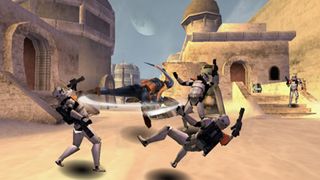
As shown, this era of Star Wars games was an excellent opportunity for creators to explore this universe from the perspective of all-new characters. They didn't even need to be human – a point proven by Star Wars: Lethal Alliance when it released exclusively for handheld consoles in 2006. Set snugly between the events of Revenge Of The Sith and A New Hope, it tells the story of Twi'lek mercenary Rianna Saren, who teams up with security droid Zeeo to thwart the Imperial Army's growing forces and aid Princess Leia's Rebel Alliance.
Developer Ubisoft Montreal knew it'd be a challenge to create a third-person action game without lightsabers, though, and still have it be exciting. True, this was a bite-sized adventure intended for the Nintendo DS and PSP, but the intention was always for Lethal Alliance to be just as ambitious as other contemporary Star Wars games despite a shrunken scope. The team pulled this off by fully capitalising on Rianna and Zeeo's unique two-person partnership, almost developing a Ratchet & Clank-esque camaraderie between the pair and integrating this into gameplay.
"The focus was to play an acrobatic spy – Rianna – meaning acrobatics and blasters gunplay and find interesting combo mechanics with Zeeo the droid," reveals lead game designer Philippe Baude. This unique setup wasn't without its development hurdles. "It was actually super hard to find how the two of them could interact," he continues. "Of course, Zeeo as a droid could do the hacking... but could he do more? How could he be useful in a blaster fight? How can he support the acrobatic skills of Rianna? We really worked hard for a few months to establish his skills and how to create those cool combos."
This inspired occasions where Rianna must defend Zeeo from fire as he sliced through to the next area, and giving her the ability to launch him at any unsuspecting enemies for a successful (and satisfying) stun. At its most creative, Star Wars: Lethal Alliance has Rianna send Zeeo up high for use as an anchor point when swinging or sliding across large ravines. Small touches like these helped Ubisoft Montreal's take stand apart from other Star Wars shooters, while leaning into the IP's most underutilised aspects. "Having a droid as one of the main characters was so cool and so Star Wars: it was a no-brainer," Baude says, "and actually, when you look at the whole saga, the real hero might be R2-D2. He's saving everybody from Episode 1 to Episode 6. Without him, there is no 7, 8 and 9."
Is Baude surprised there hasn't been a Twi'lek, or any other non-human character, leading a Star Wars game in the years since Lethal Alliance's release? "Yes and no," he considers. "It's always easier for people to have a direct connection with something close to them. So 'humans' in [the] Star Wars universe is the easier road. But recently with official TV spin-offs like Rebels or even The Clone Wars, they introduce strong alien female characters. Ahsoka Tano will have her own show and I am sure that we will soon see Hera Syndulla in a live-action TV show." Could a game follow soon after?
On the battlefront
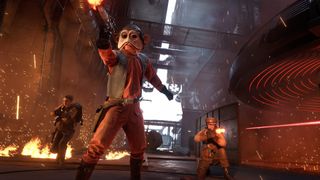
Speaking of alternate perspectives in Star Wars, one never explored too much (at least in the prequel trilogy itself) is that of the Republic's Clone Army. TV shows like The Clone Wars, as Philippe mentioned, have done a great job at addressing this since even before Disney's acquisition in 2012, but video games were once again well ahead of this curve. Because while the clashes between droids and clones were largely kept as background on the silver screen, games like Star Wars: Battlefront and Republic Commando enabled you to live out these epic confrontations right on the frontlines. "The fact that the major battles from Star Wars had never been explored from the grunt level was a compelling pitch", reveals Peter Dellekamp Siefert, designer on both of Pandemic's original Star Wars: Battlefront games.
"The internal message, 'Relive all the classic battles of Star Wars, any way you want,' was developed by [game director] Eric Gewirtz and [studio COO] Greg Borrud. The realisation that you could play with ‘all the action figures and vehicles' was a huge call back to all of our youths." Star Wars already had a great track record for letting players take flight via Factor 5's various Rogue Squadron games, but never before had large-scale ground battles received similar treatment.
The realisation that you could play with 'all the action figures and vehicles' was a huge call back to all of our youths.
Peter Dellekamp Siefert
Battlefront (2004) was the game to finally change this, however, focusing on objective-based first and third-person shooting that saw up to 32 players duke it out across battles from both the original and prequel trilogies. Multiplayer being the core gave Pandemic a rare chance to expand on all four factions' class structures. Soldier, Engineer and Pilot archetypes were already well- established within Star Wars, but others had to be thought through more carefully. "When we got to the Special and Officer classes there were gaps in the prequels since they didn't have as much information. They hadn't benefitted from 20 years of canon the originals had," Dellekamp Siefert reveals. This inspired Pandemic to develop distinct playstyles, to encourage players to experiment with other trooper types. "At first, the Clone Commander with a chaingun was controversial, because it was using bullets and at that time most people thought projectile weapons didn't exist in Star Wars. There was plenty of back and forth because we were exploring so many aspects of the Star Wars universe where deeper questions hadn't really been considered."
The first Battlefront was such a hit, LucasArts greenlit a sequel that released a year later. Grunt-level battles would make a return, of course, yet scope increased thanks to the addition of space battles, playable heroes and a more narrative-driven single-player portion that took place between Geonosis (Attack Of The Clones) and Hoth's (The Empire Strikes Back) epic battles. "The campaign became focused on the narrative of the 501st Legion. This gave us a thread that connected the clone troopers of the prequels with the stormtroopers of the OG series," Peter explains.
Meet Delta squad
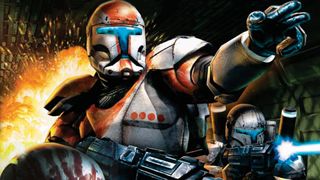
Battlefront 2's campaign did a decent enough job of highlighting the Republic army's progression in the series, but those wanting to dive more into the mindset of a clone had the chance to do so in Star Wars: Republic Commando, released earlier that same year (2005).
Developed in-house by LucasArts, the game cast players as the leader of an elite clone trooper unit called Delta Squad, following their exploits in the Clone Wars, all as they learned to bond and work together as a team. New Zealand actor Temuera Morrison returned to lend some authenticity to the game's clone troopers through voice, but how do you go about giving what should be identical clones a distinct personality?
"At first, there was some internal resistance to the ideas that the clones would be differentiated at all," explains Republic Commando co-writer Ryan Kaufman. "But then, we began to research real soldiers, and we found some inspiration in the way that US soldiers would customise their kit, and their vehicles. They wanted to express their individuality, as a reaction against the mass brutality of war. You can imagine the clones feeling the same way, especially facing off against a mass-produced droid army. That example began to resonate, and people embraced differentiation between clones."
It was important to make Scorch, Fixer, Sev and player character Boss all feel unique, not least as hearing the same voice shout "get moving" or "need Bacta" over and over could get a little stale. The same passion for variety is found in Republic Commando's FPS gameplay. Because while gunning down enemies is key, LucasArts also ensured to give players a suite of different tactical options as the unit's leader. So much so that telling Delta Squad to set up vantage points and sniper positions eventually becomes second nature. Players get to blast their way through three key battles set between the events of Episode 2 and the then-unreleased Episode 3 as part of Republic Commando's campaign. And though you'd think such a tight time period would be too restricting for LucasArts to creatively work in, Justin Lambros – another one of the game's writers – says it was far from the case.
The key was to pay respect to the legacy of other successful Star Wars-set military shooters. "Geonosis was an obvious early inspiration from Attack Of The Clones and it also lent itself to that dark and eerie Aliens vibe which was shown off so well in the early teaser trailer for the game," says Lambros. "The RAS Prosecutor was a great way to pay homage to the original Dark Forces game, which was such a groundbreaking experience for Star Wars games (and shooters at the time) and next to Hoth, onboard a starship is the next most common location for a Star Wars game to take place. Then Kashyyyk was a major location from the Revenge Of The Sith movie that fans had been clamouring to see, so that made tons of sense as a location."
Unleashing the Force
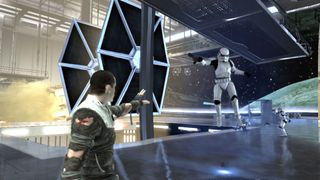
Following the prequel trilogy's completion, it'd be fair to say that thoughts towards Star Wars had somewhat soured. Anakin Skywalker's transformation into Darth Vader had disappointed a large portion of the fanbase, and with no more Star Wars movies seemingly in sight, the job to continue fleshing out this universe again fell to videogames. This inspired LucasArts to reignite excitement by developing a different type of Jedi game, one that would let players unleash the power of the Force like never before.
The release of Star Wars: The Force Unleashed in 2008 saw players take on the role of Starkiller in the aftermath of Episode 3, operating as Vader's secret apprentice who hunts down survivors of the Jedi purge. Him being such a powerful Force user led LucasArts to get Industrial Light & Magic involved and develop a new engine using early PS3/ Xbox 360 dev kits. It was the only way to do the abilities of a Jedi justice.
As art director Matt Omernick puts it, "We were doing a lot of things new. We were reimagining the Force." In order to achieve this lofty ambition, LucasArts put together a previs demo that showcased Starkiller's physics-defying Force powers. "One was a Force repulse," Omernick explains, "which was kind of him coming in and then blasting. Then there was using the Force to throw stormtroopers around and bang them against the wall. Then we had a giant Force push that moved vehicles and scattered everything in front of it." These explosive gameplay elements combined with snappy lightsaber combat that let players slice enemies limb from limb.
We were doing a lot of things new. We were reimaging the Force.
Matt Omernick
These exaggerated abilities may have been the main focus to create what director Haden Blackman described as the "superheroes of the Star Wars Universe", but The Force Unleashed was also developed with the mindset of bridging the gap between the prequel and original trilogies. This meant creating an internal conflict within Starkiller, giving him fully developed companions in Juno and Proxy, and faithfully portraying this transitional period through the visuals and art design.
"To craft the sweet spot we started with the stormtrooper helmet," Omernick reveals. "What would it look like in this era? The Rogue Shadow [Starkiller's ship] was another one of those where we were starting to not only blend the kind of tech and what ships might look like, but using the art to subconsciously start to tell the story of Starkiller's shifting his psyche, right? That ship is a nice blend between a TIE fighter and an X-wing in lots of ways. It's one of my favourite designs for all those reasons, and because it became a Lego set."
The Force Unleashed 2 followed in 2010 and while it further fleshed out the story of Starkiller and built upon the spectacular Force-based powers that proved so popular in the original game, it wasn't as critically acclaimed and would prove to be the last big Star Wars game before the Disney buyout in 2012, which saw the House Of Mouse buy LucasFilm for a staggering $4.05 billion. Canon or not, so much effort went into games developed for the original Star Wars EU, it's no shock to see Disney pay at least some attention to the past.
If anything, granting every game released before 2014 the status of 'Legend' makes their light burn even more brightly within the hearts of players, letting them act as beacons that could potentially inspire future generations of Star Wars games. While Chris Foster would love to see Kyle Katarn "become a mystery – someone whispered about, perhaps, but not seen", other developers like the door being open for Legends material to be integrated in the future. After all, as Ryan Kaufman sums up, "These stories and characters resonate with so many people on so many levels."
This article first appeared in issue 223 of Retro Gamer magazine.
Aaron is a freelance writer who appreciates a good video game story just as much as great visuals and gameplay. Having covered the subject for places like WIRED, Den of Geek, PLAY Magazine, NME, PC Gamer and more, he’s well equipped to discuss a range of topics and industry goings-on through in-depth features, developer interviews and thoughtful reviews. His favourite game ever is 2005’s TimeSplitters: Future Perfect, a madcap character shooter from the makers of GoldenEye 007 that he first played whilst on holiday in Butlin’s Minehead. Because who needs to have fun in the sun, anyway?

